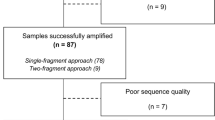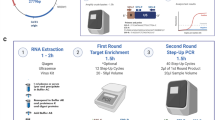Abstract
Patients infected with human irnmunodeficiency virus type 1 (H1V-1) are being treated with a number of different combinations of antiretroviral compounds that target the essential viral enzymes reverse transcriptase and protease. Different sets of HIV-1 mutations that confer drug resistance have been well defined; they allow reasonabe prediction of the drug sensitivity pattern from analysis of the HIV-1 genotype in vivo. Since periodical monitoring of genotypic resistance is expected to improve clinical management in a large number of infected patients, practical and cost-effective methods are highly desirable to set at least medium-scale sequencing in clinical diagnostic settings. We present a complete protocol for direct sequencing of HIV-1 reverse transcriptase and protease-coding regions. Features making the system amenable to routine clinical use include:
-
1.
Highly robust presequencing steps (plasma RNA extraction, reverse transcription, and nested PCR);
-
2.
Direct use of the crude unpurified PCR product as the sequencing template; and
-
3.
Use of infrared-labeled sequencing primers consistently allowing long reads, thus obviating the need for sequencing of both DNA strands.
Similar content being viewed by others

References
Hammer, S. M. (1996) Advances in antiretroviral therapy and viral load monitoring.AIDS 10, s1-s11.
Perelson, A. S., Neumann, A. U., Markowitz, M., Leonard, J. M., and Ho, D. D. (1996) HIV-1 dynamics in vivo: virion clearance rate, infected cell life-span and viral generation time.Science 271, 1382–1386.
Coffin, J. M. (1995) HIV population dynamics in vivo: implications for genetic variation, pathogenesis and therapy.Science 267, 483–489.
Larder, B. A. (1995) Viral resistance and the selection of antiretroviral combinations.J. Acquir. Immune Defic. Syndr. Hum. Retrov. 10, s28-s33.
Panwels, R., Andries, K., Debyser, Z., Kukla, M. J., Schols, D., Breslin, H. J., Woestenborghs, R., Desmyter, J., Janssen, M. A., and De Clercq, E (1994) New tetrahydroimidazo[4,5,1-jk][1,4]-benzodiazepin-2(1H)-one and-thione derivatives are potent inhibitors of human immunodeficiency virus type 1 replication and are synergistic with 2′,3′ dideoxynucleoside analogs.Antimicrob. Agents Chemother. 38, 2863–2870.
Larder, B. A., Kemp, S. D., and Harrigan, P. R. (1995) Potential mechanism for sustained antiretroviral efficacy of AZT-3TC combination therapy.Science 269, 696–699.
Schinazi, R. F., Larder, B. A., and Mellors, J. W. (1996) Mutations in retroviral genes associated with drug resistance.Int. Antiviral News 4, 95–107.
Moyle, G. J. (1996) Use of viral resistance patterns to antiretroviral drugs in optimising selection of drug combinations and sequences.Drugs 52, 168–185.
Larder, B. A., Kellam, P., and Kemp, S. D. (1991) Zidowdine resistance predicted by direct detection of mutations in DNA from HIV-infected lymphocytes.AIDS 5, 137–144.
Frenkel, L. M., Wagner, II L. E., Atwood, S. M., Cummins, T. J., and Dewhurst, S. (1995) Specific, sensitive, and rapid assay for human immunodeficiency virus type 1 pol mutations associated with resistance to zidovudine and didanosine.J. Clin. Microbiol. 33, 342–347.
Stuyver, L., Wyseur, A., Rombout, A., Louwagie, J., Scarcez, T., Verhofstede, C., Rimland, D., Schinazi, R. F., and Rossau R. (1997) Line probe assay for rapid detection of drug-selected mutations in the human irnmunodeficiency virus type 1 reverse transcriptase gene.Antimicrob. Agents Chemother. 41, 284–291.
Zazzi, M., Catucci, M., De Milito, A., Romano, L., Venturi, G., Almi, P., Gonnelli, A., Rubino, M., and Valensin, P. E. (1996) Zidovudine resistance mutations and human immunodeficiency virus type 1 DNA burden: longitudinal evaluation of six patients under treatment.Infection 24, 419–425.
Kellam, P. and Larder, B. A. (1995) Retroviral recombination can lead to linkage of reverse transcriptase mutations that confer increased zidovudine resistance.J. Virol. 69, 669–674.
Zazzi, M., Romano, L., Toneatto, S., Peruzzi, F., De Milito, A., Botta, G., and Valensin, P. E. (1993) Optimal conditions for detection of human immunodeficiency virus type 1 DNA by polymerase chain reaction with nested primers.Mol Cell Probes 7, 431–437.
Longo, M. C., Berninger, M. S., and Hartley, J. L. (1990) Use of uracil DNA glycosylase to control carry-over contamination in polyrnerase chain reactions.Gene 93, 125–128.
Author information
Authors and Affiliations
Corresponding author
Rights and permissions
About this article
Cite this article
Zazzi, M., Riccio, M.L., Venturi, G. et al. Long-read direct infrared sequencing of crude PCR products for prediction of resistance to HIV-1 reverse transcriptase and protease inhibitors. Mol Biotechnol 10, 1–8 (1998). https://doi.org/10.1007/BF02745858
Issue Date:
DOI: https://doi.org/10.1007/BF02745858



